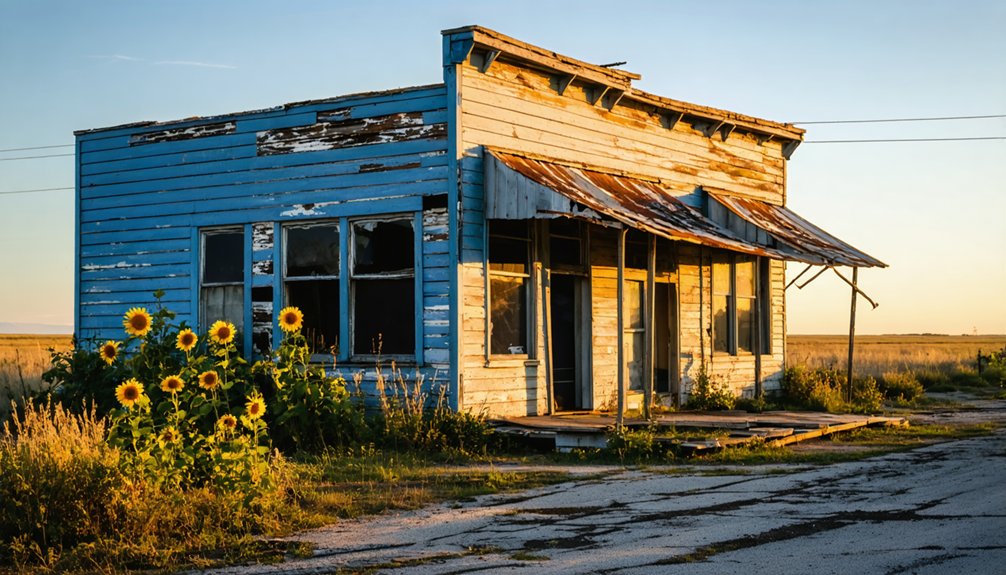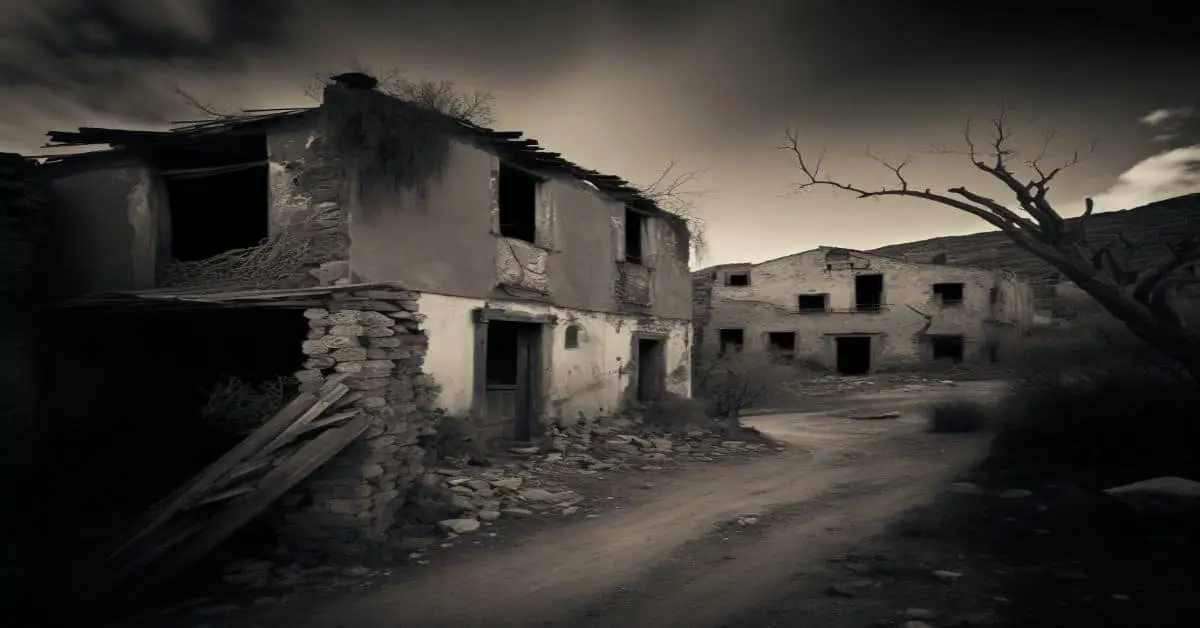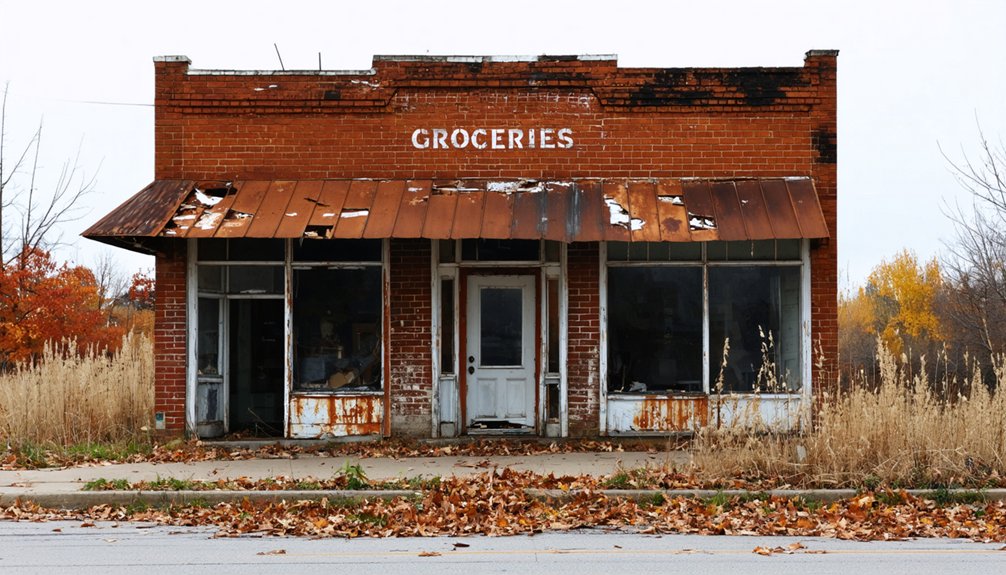You’ll find Carrollton’s ghost town ruins in Carroll County, Iowa, where it served as the original county seat from 1855 to 1869. The settlement flourished early with a courthouse, pioneer schoolhouse, and bustling merchant district until the Chicago and Northwestern Railroad bypassed it for neighboring Carroll City. This critical decision triggered Carrollton’s decline, transforming it from an essential pioneer community into an abandoned prairie settlement. The site’s remaining foundations and historical markers hold fascinating tales of frontier ambition and adaptation.
Key Takeaways
- Carrollton was established in 1851 as Carroll County’s first county seat but became a ghost town after losing railroad access.
- The Chicago and Northwestern Railroad’s decision to bypass Carrollton led to its economic decline and eventual abandonment.
- In 1869, Carrollton lost its county seat status, causing government functions and businesses to relocate to railroad-connected towns.
- The last family moved away from Carrollton in the late 1960s, completing its transformation into a ghost town.
- Today, only building foundations and cellar holes remain, preserved through historical tours and Carroll County Historical Society efforts.
The Birth of a Pioneer Settlement
When Carroll County was officially established on January 15, 1851, as part of Iowa’s westward expansion, the seeds of Carrollton’s pioneer settlement were planted.
Named after Charles Carroll of Carrollton, the last surviving signer of the Declaration of Independence, the county attracted its first settlers near crucial waterways.
You’ll find pioneer resilience exemplified by Enos Butrick, who arrived in 1851 and established a family settlement with his seven children near Purgatory Creek and the North Raccoon River.
Early settlement patterns centered around rivers, providing essential access to wood and water.
The first glimpses of community life emerged in 1854 when a Methodist circuit rider held religious services at Henry Copeland’s cabin.
The growing community held its first election in 1855, where 28 male voters gathered at Copeland’s home to participate in local governance.
The southeastern portion of Carroll County became home to Carrollton, which maintained a modest population of 45 while the surrounding township grew to 300 residents.
Early Commerce and Community Life
Three key institutions formed the backbone of Carrollton’s early development as Carroll County’s first seat of government: the courthouse built in 1858, the pioneer schoolhouse where Jane L. Hill taught, and the post office that replaced informal mail delivery from Panora’s grist mill.
As the county’s administrative center, you’d find early businesses and merchants setting up shop to serve the growing population of pioneers. While detailed records of specific enterprises are scarce, the courthouse and school became natural gathering spots for community events and daily activities. Today, the Carrollton Community Heritage Club continues preserving the town’s history through special events. The Carroll County Museum now offers educational tours highlighting the area’s rich heritage.
Before established mail service, you’d see residents helping each other by carrying letters and packages to and from Panora. The town’s social fabric grew around these cornerstones, though specific churches and organizations remain largely undocumented.
Railroad’s Fateful Decision
When the Chicago and Northwestern Railroad decided to bypass Carrollton and establish operations in Carroll City, you could witness the beginning of Carrollton’s decline as a viable settlement.
You’ll find that this pivotal decision shifted economic power to railroad-connected towns like Carroll City and Coon Rapids, which quickly developed essential infrastructure including warehouses and mercantile establishments. The railroad’s presence led to significant growth, with the establishment of two branch lines from Carroll in 1877 and 1880.
The railroad’s choice to route through Carroll City ultimately led to the 1869 county seat transfer, cementing your understanding of how rail access determined a town’s survival in 19th century Iowa. The abandoned buildings in Carrollton were eventually repurposed by residents, showing how the community adapted to its diminished status.
Railroad Route Selection Process
As the Chicago and Northwestern Railroad plotted its expansion through Carroll County in the mid-1800s, the route selection process involved multiple stakeholders vying for influence over the tracks’ placement.
You’d find engineers conducting technical surveys while local boosters actively engaged with railroad officials to promote their preferred alignments. These route influences weren’t just about geography – they reflected a complex interplay of community interests and corporate decision-making.
The railroad’s choices demanded careful consideration of topography and construction feasibility, but local engagement often proved decisive. The Ogle & Carroll segment established in 1857 would become an important part of the developing rail network. The Stanford University Press publication provided extensive documentation of how railroads made these critical routing decisions.
Despite official routing decisions sometimes being made in distant cities like Detroit, communities maintained their influence.
You’ll notice how town plats shifted to align with tracks, and even when bureaucrats chose different paths, local usage patterns sometimes preserved alternative routes through main streets.
Economic Impact of Bypass
Since the railroad’s decision to bypass Carrollton, economic data from similar Iowa communities reveals a consistent pattern of declining retail activity in bypassed towns.
You’ll find these bypass effects particularly evident in Iowa’s rural communities, where merchants frequently report decreased customer traffic and sales after transportation routes change. Recent studies show rail traffic indicators have historically predicted these economic shifts in small towns.
- Convenience goods sellers often weather the retail decline better than shops selling discretionary items.
- Local businesses typically must adapt by shifting focus from traveler trade to resident-focused services.
- Employment in retail and service sectors tends to contract as customer bases shrink.
- Downtown properties may face vacancy challenges, though some communities find opportunities for redevelopment.
The economic impact studies from eleven Iowa communities show measurable shifts in retail patterns post-bypass, with many towns struggling to maintain their previous levels of commercial activity. A comprehensive personal survey of businesses in bypassed communities helped researchers understand the full scope of economic changes.
Neighboring Towns’ Rail Success
The fateful decision by the Chicago & Northwestern Railroad to bypass Carrollton in 1869 created a stark contrast between the town’s decline and the remarkable success of its rail-connected neighbors.
While Carrollton withered, you’ll find that railroad expansion transformed nearby communities into thriving commercial centers. Towns like Hancock, Oakland, and Carson flourished along Burlington and Rock Island branch lines, while Coon Rapids prospered on the St. Paul route.
The economic disparities became even more evident as Council Bluffs evolved into a major rail hub, boasting eight depots by 1883.
You can trace the pattern of success through communities like Underwood and “New” Macedonia, which sprang up along strategic rail routes, securing their futures through essential transportation connections that Carrollton lacked.
Decline and Abandonment
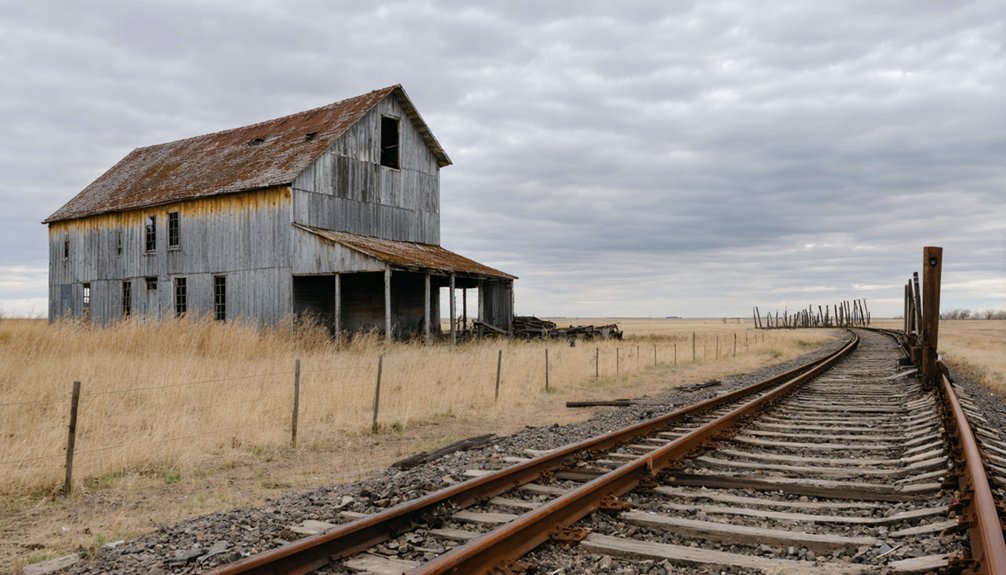
During the late nineteenth century, Carrollton’s decline began when the Northwestern Railroad chose to bypass the town, triggering a cascade of economic setbacks that would ultimately lead to its abandonment.
The loss of both rail access and county seat status dealt devastating blows to community resilience, sparking widespread urban migration.
Left without rail service and stripped of its governmental role, Carrollton withered as residents fled to urban centers.
You’ll find that Carrollton’s story of decline unfolded through these critical factors:
- The relocation of government functions to Carroll stripped away essential economic activity
- Local businesses and residents relocated closer to railroad lines, depleting the tax base
- Schools, shops, and community institutions closed as population dwindled
- The advent of automobiles and modern transportation made Carrollton’s location increasingly irrelevant
The town’s infrastructure never modernized to meet changing times, and the aging population gradually abandoned their homes, transforming Carrollton into a ghost town.
Legacy in Carroll County
While Carrollton’s physical presence faded into obscurity, its enduring legacy as Carroll County’s original seat of government remains firmly etched in local history.
You’ll find Carrollton’s significance preserved through ghost town tours, historical society programs, and county archives that highlight its pivotal role in establishing local governance.
The town’s legacy lives on in the stories of the first county election of 1855, where settlers gathered to shape their community’s future, and in the Methodist services that laid the foundation for the area’s cultural identity.
Today, Carrollton serves as a powerful reminder of rural Iowa’s pioneering spirit, and you can trace the county’s evolution through its shift from this original settlement to the current county seat of Carroll.
Historical Sites and Landmarks
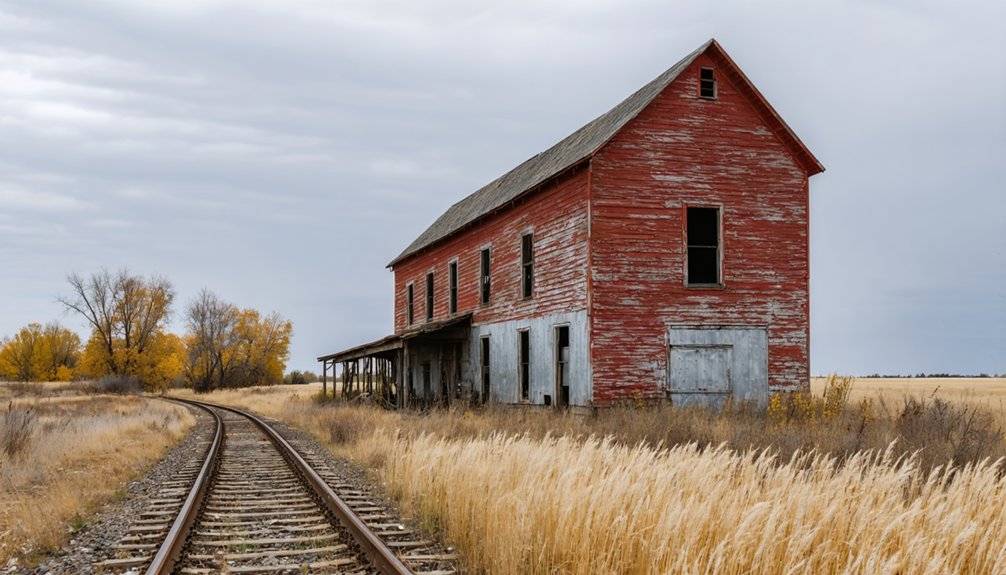
Remnants of Carrollton’s once-bustling town center have largely disappeared from the landscape, though you’ll find its heritage preserved through carefully placed historical markers and guided tours.
The Carroll County Historical Society maintains the historical preservation of Carrollton’s legacy through exhibits and commemorative signage that mark significant locations across the former townsite.
You can explore Carrollton’s community heritage through these key features:
- The Carroll County Museum’s dedicated exhibits showcasing artifacts and photographs
- Historical markers identifying former business and government building locations
- Ghost town bus tours departing from the museum, featuring local storytelling
- Archaeological sites revealing foundations and cellar holes from the original settlement
These elements help you connect with Carrollton’s past despite limited physical remains of this former county seat.
Tales From Former Residents
You’ll hear vivid accounts of daily life from former residents who recall the bustling general store, weekly church gatherings, and seasonal farming activities that once defined Carrollton’s pioneer spirit.
Their memories paint a bittersweet picture of the final moving day in the late 1960s, when the last family packed their belongings and closed the door on their family home for good.
Former residents often share stories of community picnics, holiday celebrations, and barn-raising events that exemplified the tight-knit social fabric before the town’s gradual decline.
Daily Pioneer Life Memories
Through the shared memories of former Carrollton residents, a vivid picture emerges of daily pioneer life in this once-thriving Iowa settlement.
You’ll find stories of pioneer traditions and daily struggles that shaped the community’s resilient spirit in southeastern Section 36.
Life in Carrollton revolved around these defining experiences:
- Adapting to Iowa’s harsh seasons, from sweltering summers to bone-chilling winters that tested every settler’s resolve
- Gathering at community events where families shared stories and traditions, strengthening their social bonds
- Working the fertile soil around Carrollton, where farming was both a necessity and a way of life
- Maneuvering through the challenges of isolation, especially after the Northwestern Railroad bypassed the town, forcing residents to adapt their trade patterns
These memories capture the essence of frontier life before Carrollton’s eventual decline.
Last Family’s Moving Day
While the gradual decline of Carrollton unfolded over several years, the departure of its last remaining family in the late 1800s marked a poignant end to the once-vibrant settlement.
You’ll find their final memories intertwined with the town’s economic hardships, as the Northwestern Railroad’s decision to bypass Carrollton had already sealed its fate.
The last family packed their belongings amid vacant buildings and shuttered businesses, saying emotional farewells to a place that had lost its liveliness.
They’d witnessed the deterioration of roads, the closure of essential services, and the slow exodus of neighbors.
With poor soil conditions hampering agriculture and no promising job prospects in sight, they left behind empty structures that would stand as silent testimonies to Carrollton’s forgotten dreams.
Community Gatherings Before Decline
Before Carrollton’s decline in the late 1800s, vibrant community gatherings served as the heartbeat of this Iowa settlement.
You’d find residents coming together regularly in multipurpose town halls, churches, and schools for social gatherings that strengthened their bonds and celebrated their shared experiences.
The community events that defined Carrollton’s spirit included:
- Annual harvest festivals and agricultural fairs that showcased the town’s farming heritage
- Seasonal dances in public halls where neighbors socialized and enjoyed visiting entertainers
- Church-organized social programs that brought families together for fellowship
- Community picnics and outdoor gatherings during warmer months where residents could freely interact
The Carrollton Community Heritage Club now preserves these memories, honoring a time when social connections flourished before the railroad’s bypass led to the town’s gradual dissolution.
Preservation Efforts Today
Today, the Carroll County Historical Society leads preservation efforts for Carrollton’s historic legacy, with board members Barbara Hackfort and Gayle Dean spearheading annual ghost town tours that prioritize historical education over supernatural lore.
You’ll find these four-hour tours have become a cornerstone of ghost town preservation, connecting you with the area’s rich past through carefully curated experiences.
The Society’s commitment to community engagement extends beyond tours. You can access brochures and video resources at the Carroll Chamber of Commerce and County Museum, while local historians work diligently to document oral histories and photograph remnants of this vanished community.
While there aren’t dedicated school programs or archaeological sites specifically for Carrollton, the Historical Society’s focus on education over entertainment guarantees the ghost town’s stories endure for future generations.
Ghost Town Tourism Experience
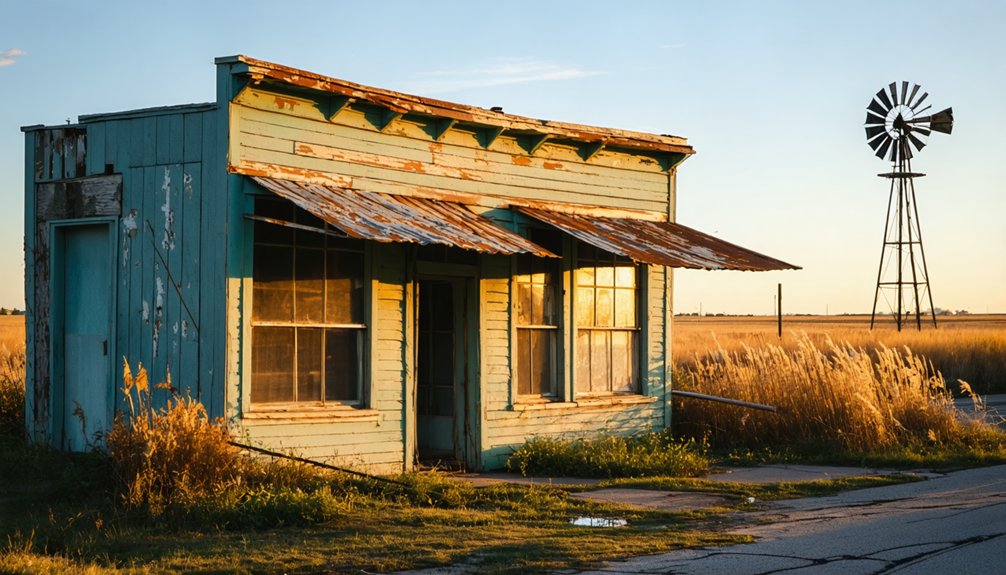
Visitors to Carrollton’s ghost town experience will find themselves transported through time during the Carroll County Historical Society‘s annual October tours.
Your journey through Iowa’s rural history comes alive through expert storytelling and ghost town photography opportunities among the scattered remnants of the past.
Lessons From Lost Prairie Towns
While many small prairie towns vanished into history, their stories offer essential lessons about the fragile nature of rural settlements.
You’ll find that transportation evolution played a decisive role, as railroad route decisions could either guarantee a town’s prosperity or doom it to obscurity, as happened with Carrollton when the Northwestern Railroad bypassed it.
Urban migration patterns emerged as towns lost crucial administrative functions, like when Carrollton surrendered its county seat status to Carroll.
The shift to automobiles and rural mail delivery transformed how people accessed goods and services, making many small trading centers obsolete.
Nature’s fury, exemplified by Elkport’s devastating 2004 flood, reminds you that environmental factors can swiftly erase even established communities from the map.
Frequently Asked Questions
Are There Any Remaining Structures or Foundations Visible in Carrollton Today?
You’ll find virtually no visible structures left today, with any remaining foundations likely hidden beneath vegetation and soil. Limited ruins distinguish this site from other Iowa ghost towns.
What Native American Tribes Originally Inhabited the Carrollton Area?
You’ll discover the rich cultural heritage of the Sioux and Pottawatomi tribes, who dominated this region’s tribal history. Their territories met at the War Path, where they competed for prime hunting grounds.
How Many People Lived in Carrollton at Its Peak Population?
While there’s no definitive record of peak population growth, you’d find historical significance in estimates suggesting several hundred residents at most during Carrollton’s prime before it became a ghost town.
Were There Any Notable Crimes or Scandals in Carrollton’s History?
Unlike Salem’s mysterious disappearances or local legends that haunt other ghost towns, you won’t find documented crimes or scandals in Carrollton’s history. Its decline stemmed purely from economic factors.
Did Any Famous Historical Figures Ever Visit or Stay in Carrollton?
You won’t find records of any famous visitors having graced Carrollton’s streets. Despite its historical significance as an early Carroll County settlement, no nationally recognized figures are documented to have visited.
References
- https://www.onlyinyourstate.com/experiences/iowa/ia-ghost-town
- https://jackandkitty.com/iowa-ghost-towns/
- https://pubs.lib.uiowa.edu/annals-of-iowa/article/id/6960/download/pdf/
- https://www.1380kcim.com/2024/09/28/carroll-county-historical-society-hosts-ghost-town-tour-oct-6/
- https://genealogytrails.com/iowa/carroll/town_info.htm
- https://www.carrolliowa.com/history-of-carroll
- https://www.iowalincolnhighway.com/counties/carroll-2/
- https://archive.org/stream/historyofcarroll02macl/historyofcarroll02macl_djvu.txt
- http://www.iowapbs.org/iowapathways/mypath/2542/pioneer-family-comes-iowa
- https://books.google.com/books/about/History_of_Carroll_County_Iowa.html?id=nYQUAAAAYAAJ
